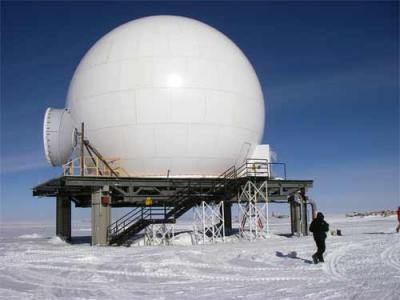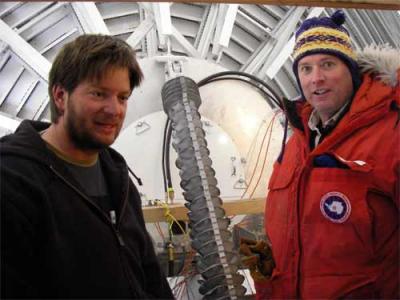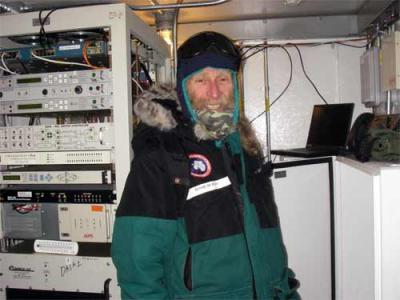Satellites at the South Pole. Welcoming a new member of the research team!
Temperature: - 25.7 C, - 14.3 F Windchill: - 30.9 C, - 23.6 F Wind: 2.9, Grid 158 Weather: sunny with scattered high clouds, over casting during the evening.
Before I am reporting again about yet another amazing day at South Pole learning about our satellite communication, let me welcome Teresa, a new member of the NOAA team. She arrived from Barrow, Alaska, leaving on the 30th of December and arriving here on the 5th of January. She literally went from almost the North Pole (Barrow is 1250 miles away from the North Pole) to the South Pole: from almost 24 hour darkness and Arctic winter temperatures to 24 light and Antarctic summer temperatures. Teresa is an electronic technician and she has been living with her husband in Barrow for 4 years working at the NOAA clean air facility right outside from Barrow.
She never flew a stratospheric balloon. Being Monday our scheduled strato-day , Andy taught her all the trades and Teresa flew her first stratospheric balloon:
Teresa and Andy are filling the balloon

Teresa signed her first ozonesonde and I endorsed it!

Teresa is leaving the BIF
 Andy is assisting Teresa while she is leaving the BIF with the balloon.*
Andy is assisting Teresa while she is leaving the BIF with the balloon.*
Andy instructing in ballooning
 Andy is giving Teresa instructions in how to let go of the balloon and the ozonesonde.*
Andy is giving Teresa instructions in how to let go of the balloon and the ozonesonde.*
It was a successful flight!
Before this flight, I went with Jessie Duffin and Pete Allen, both Satellite communications engineers, to the satellite area of the station. They were going to test the new translation gear on one of the satellites. Rich, their chief engineer from McMourdo and Joe, a fire installation specialist came along as well. We have 2 satellite-receivers.
Outside of one of our satellite receivers

Elke and the satellite communication
 Elke and the satellite communication crew in front of the satellite dish. Notice how the dish is facing towards the horizon. This is important since the satellite will only rise up to 5 degree over the horizon. With 3 satellites combined we can have up to 11 hours of satellite connection. This dish has been broken, so we had about 6 hors of satellite connection per day. The satellites rise over the horizon 5 minutes earlier every day.
Elke and the satellite communication crew in front of the satellite dish. Notice how the dish is facing towards the horizon. This is important since the satellite will only rise up to 5 degree over the horizon. With 3 satellites combined we can have up to 11 hours of satellite connection. This dish has been broken, so we had about 6 hors of satellite connection per day. The satellites rise over the horizon 5 minutes earlier every day.
Pete is observing the translation gear of the satellite dish.
 Pete is observing the translation gear of the satellite dish while Joe, Jessie and, Richard were running tests while the telescope moved 40 degrees up and down. *
Pete is observing the translation gear of the satellite dish while Joe, Jessie and, Richard were running tests while the telescope moved 40 degrees up and down. *
Richard and Joe next to the jack-screw of the telescope
 Richard and Joe next to the jack-screw of the telescope, the arm that holds the satellite dish. Richard is the Chief engineer, and Joe Tarnow is the fire protection specialist.
Richard and Joe next to the jack-screw of the telescope, the arm that holds the satellite dish. Richard is the Chief engineer, and Joe Tarnow is the fire protection specialist.
Jessie and the satellite control center
 Jessie and the satellite control center. Jessie will be released by Pete who will winter-over. Jessie used to work in submarines. After his NAVY times, he has been coming to Antarctica many times. He is planning to hike mountains in Africa when he gets off the ice.*
Jessie and the satellite control center. Jessie will be released by Pete who will winter-over. Jessie used to work in submarines. After his NAVY times, he has been coming to Antarctica many times. He is planning to hike mountains in Africa when he gets off the ice.*
Will, the chief of the SPS fire and Rich department
 Will, the chief of the SPS Fire department came with his team fro inspections.
Will, the chief of the SPS Fire department came with his team fro inspections.
Carla, Pete and Jessie in the satellite computer center
 In the mean time, Carla, Pete and Jessie were in the satellite computer center to solve some problems.
In the mean time, Carla, Pete and Jessie were in the satellite computer center to solve some problems.
Mike Sharpe, John Miller, and Elke in front of the high voltage closet
 Mike Sharpe, John Miller, and Elke in front of the high voltage closet. Both came to remove this closet and conduct some repairs. Mike is also communicating with classrooms of his home town.*
Mike Sharpe, John Miller, and Elke in front of the high voltage closet. Both came to remove this closet and conduct some repairs. Mike is also communicating with classrooms of his home town.*
Elke on top of the RF Building
 Elke on top of the RF (radio frequency) Building, the station is in the background . I am standing next to the second satellite dish.*
Elke on top of the RF (radio frequency) Building, the station is in the background . I am standing next to the second satellite dish.*
As I was observing all the activities in the satellite communication department and enjoyed their explanations, both Jessie and Rich pointed out to me that a plane will land soon. They offered to watch its landing from their satellite housing platform. That was amazing: The "Herc” landed right in front of me!
"Herc” about to land!

A "Herc” has landed.

It was an incredible encounter to see and imgine the satellite communication for the South Pole. All the communication and data transfer relies on it. Thank you Satellite team for everything!
Answer to yesterday’s question of what the food was like when Paul Siple was at the Pole during the IGY time: They brought mostly food in cans and frozen fish and meat. We have come a long way, now having a green house at the station and getting "freshies” regularly.
Question: What kind of science did Siple conduct at the South Pole?

